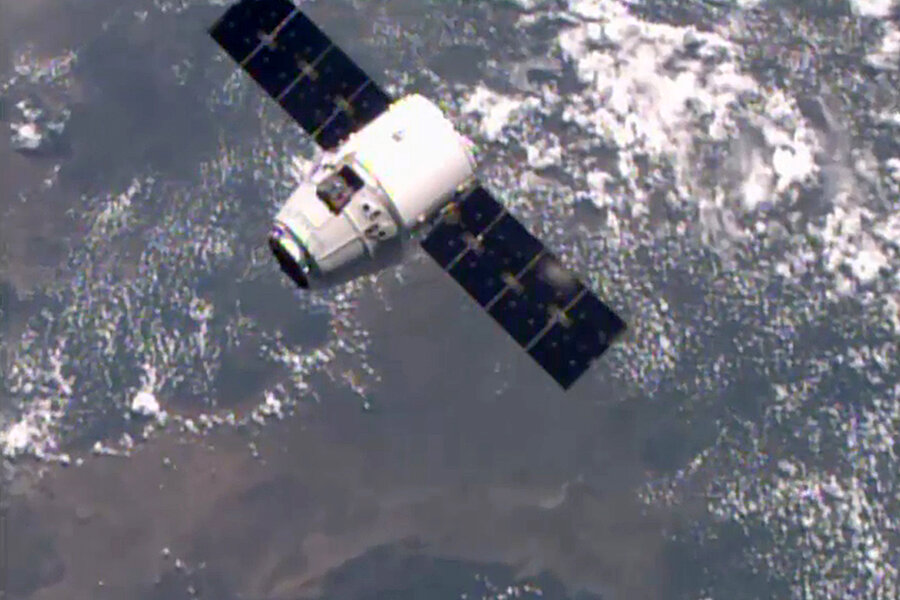Can rockets have an eject button? SpaceX to take on key safety test
Loading...
NASA's effort to turn the task of ferrying astronauts to and from the International Space Station over to private launch services reaches a milestone Wednesday morning.
One of two companies that the National Aeronautics and Space Administration has tapped for the job, Space Exploration Technologies Corp. (SpaceX), is set to test a safety system designed to speed a Dragon crew capsule away from a badly malfunctioning rocket.
The test, known as a pad-abort test, focuses on getting crew and capsule safely out of harm's way should its Falcon 9 rocket teeter on the brink of a catastrophic failure at the pad.
But more is riding on this test than the future of a shuttle service for NASA astronauts, contends Jon Cowart, NASA's commercial-crew liaison with SpaceX. The test also represents a step toward making space travel safer for people in general.
When NASA started supporting the development of human spaceflight capabilities in the private sector, it wasn't to taxi crews to and from the space station, he explained during a recent briefing previewing the test.
"Our objective ... was to enable the private sector to develop rockets and spaceships to carry anybody into space," he said. "If you're going to develop a private-sector capability, let's make it as safe as possible for anybody.
"We're doing something historic here," he continued. "If you believe in the future where two, three, four generations from now our kids, grandkids, great-grandkids go to a spaceport the way you and I go to an airport and they get on a rocket ... the DNA of that private-sector capability will be in what we are doing with the commercial-crew program," he said.
SpaceX and Boeing, the second of NASA's two providers, aren't alone in working with that DNA.
For instance, on April 29, Blue Origin, another relative newcomer to space transport, successfully conducted the first development launch of its New Shepard capsule using a homegrown liquid-fuel rocket. The system is designed for quick up-and-down suborbital trips. Blue Origin conducted a successful pad-abort test in 2012 using a system conceptually similar to the one that SpaceX is testing Wednesday.
Blue Origin, headed by Amazon.com founder and Washington Post owner Jeff Bezos, also has worked with NASA's commercial-crew development program and aims to field a space-transportation system for reaching low-Earth orbit as well. Like SpaceX, Blue Origin is developing reusable boosters than can land vertically after a launch.
Meanwhile, a fourth company, Sierra Nevada Corp., has scheduled the first test launch of its Dream Chaser, a mini space shuttle, for November 2016.
At first blush, the notion of including a mission-abort system to spring astronauts free of a rocket in the event of a catastrophic malfunction would seem to be a no-brainer. NASA's Mercury and Apollo craft sported towers with rocket motors. Gemini capsules had ejection seats. But the space shuttles had none of these; their design left no practical way of carrying astronauts free of a stricken orbiter at critical stages of flight. The Challenger disaster in 1986 bared that deficiency.
Little surprise that NASA included a means of safely separating astronauts from a stricken rocket as a vital requirement if new craft were to be certified to carry people.
Assuming all goes as planned, SpaceX's test Wednesday morning will last only about 90 seconds. The test capsule sits atop a short cylinder at its launchpad at the Cape Canaveral Air Force Station on Florida's east coast. The cylinder serves as a mock second stage for the Falcon 9 rocket that SpaceX will use to loft crews.
Unlike the early days of human spaceflight, the rocket motors for SpaceX's escape system are not mounted on a tower-like structure sprouting from the top of the capsule. Instead, eight powerful motors built into the sides of the capsule will kick it free of the mock booster. The motors will burn for about six seconds, sending Dragon arcing to an altitude of 4,500 feet, then to a water landing about a mile from the launchpad, according to Hans Koenigsmann, vice president for mission assurance at SpaceX.
A tower is one more piece of hardware that must be jettisoned during ascent, introducing an additional element of risk to the system if it fails to jettison properly, Dr. Koenigsmann explained during the recent briefing. Moreover, mounting the motors on the capsule itself allows them to do double duty: The system also is designed to bring the capsule back to a powered landing after less hair-raising launch attempts.
Koenigsmann and Mr. Cowart emphasize that this launch is a test, so the system may not perform flawlessly.
"It doesn't have to be flawless. The point is to gather data. We can live with less than perfect," Cowart said. "No matter what happens on test day, we'll learn a lot."
"It is rocketry. You've worked really hard, you've done all your calculations – the really nerdy things. Now there's going to be some smoke and fire," he said. "That's the part that we really love."








